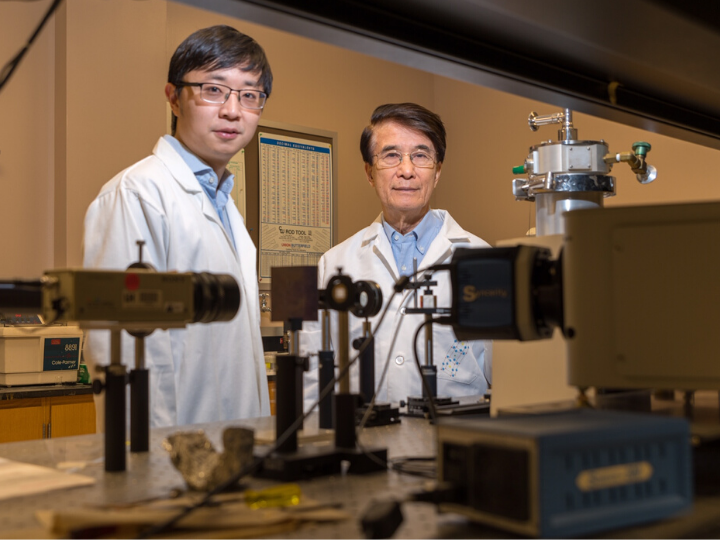Apr 15 2020
The world has become highly connected, leading to an exponential growth in the demands for data processing and storage. Thus, there is a need for new materials with the potential for more efficient data processing and storage.
 Researchers Liangzi Deng, left, and Paul Chu worked with colleagues reporting the discovery of a new compound capable of maintaining its skyrmion properties at room temperature through the use of high pressure. The work holds promise for next-generation data storage. Image Credit: University of Houston.
Researchers Liangzi Deng, left, and Paul Chu worked with colleagues reporting the discovery of a new compound capable of maintaining its skyrmion properties at room temperature through the use of high pressure. The work holds promise for next-generation data storage. Image Credit: University of Houston.
Under the guidance of physicist Paul Ching-Wu Chu, founding director of the Texas Center for Superconductivity at the University of Houston, an international research team has reported a new compound that can maintain its skyrmion properties at room temperature by using high pressure.
The results of the study, which has been reported in the Proceedings of the National Academy of Sciences, also indicate the possibility of using chemical pressure to retain the properties at ambient pressure, ensuring the potential for commercial applications.
A skyrmion is the lowest possible perturbation to a uniform magnet, a point-form region of reversed magnetization around a whirling twist of spins. These very small regions, together with the potential of moving them with very low electrical current, render the materials hosting them potential candidates for high-density information storage.
However, the skyrmion state generally occurs only at an extremely low and narrow temperature range. For instance, in the compound investigated by Chu and his team, the skyrmion state usually occurs only within a narrow temperature range of nearly 3 K, that is, between 55 and 58.5 K (or between −360.7 and −354.4 °F). This renders it unusable for a majority of the applications.
Chu, the corresponding author for the work, said the team worked with a copper oxyselenide compound and could drastically expand the temperature range at which the skyrmion state occurs, which is up to 300 K, or nearly 80 °F, near room temperature.
According to Liangzi Deng, the first author of the study, for the first time, the state was successfully identified at room temperature under a pressure of 8 GPa. They achieved this using an exclusive technique devised by him and his team. Deng is a scientist associated with the Texas Center for Superconductivity at UH (TcSUH).
Chu added that the team identified that copper oxyselenide compound experiences various structural-phase transitions with an increase in pressure, proposing the likelihood that the skyrmion state is more omnipresent than considered earlier.
Our results suggest the insensitivity of the skyrmions to the underlying crystal lattices. More skyrmion material may be found in other compounds, as well.
Paul Ching-Wu Chu, Founding Director, Texas Center for Superconductivity, University of Houston
The study proposes that it is possible to chemically replicate the pressure needed to maintain the skyrmion state in the copper oxyselenide compound, thus allowing it to work under ambient pressure, which is another crucial prerequisite for prospective commercial applications.
This has some similarities to a study by Chu and his team with high-temperature superconductivity, who reported in 1987 that they had achieved stabilization of high-temperature superconductivity in YBCO (yttrium, barium, copper, and oxygen) by substituting ions in the compound with smaller isovalent ions.
Apart from Chu and Deng, other researchers involved with the project are co-first author Hung-Cheng Wu, who is a visiting researcher at TcSUH from National Sun Yat-sen University in Taiwan; Alexander P. Litvinchuk and Rabin Dahal, both from TcSUH; Noah F. Q. Yuan from the Massachusetts Institute of Technology; Jey-Jau Lee from National Synchrotron Radiation Research Center in Taiwan; Helmuth Berger from the Institute of Physics of Complex Matter at the Ecole Polytechnique Federal de Lausanne in Switzerland; and Hung-Duen Yang from National Sun Yat-sen University.